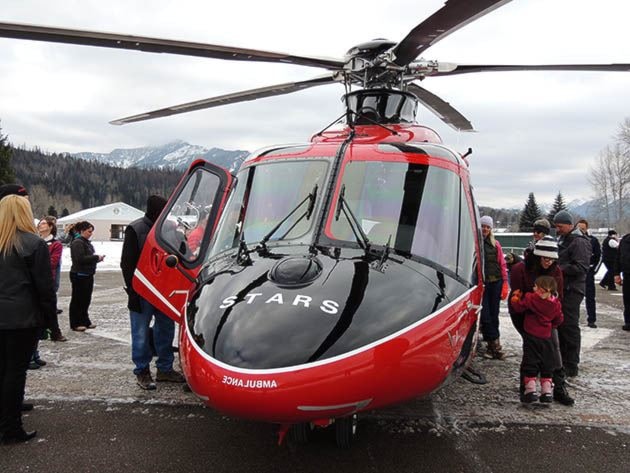STARS flew into Fernie to show their new air ambulance to the Elk Valley Hospital (EVH) staff. The STARS crew arrived in the AgustaWestland AW139 on Jan. 30 to demonstrate the procedures for side loading and unloading the helicopter which should be operational in March or April.
STARS is an independent non-profit charitable organization dedicated to providing a safe, rapid, highly specialized emergency medical transport system for the critically ill and injured with three bases in Alberta, two in Saskatchewan and one in Manitoba.
“This new helicopter can fly faster, farther and can take two patients rather than only one,” said Shirley Mercier, BScN, acute services director, Fernie and Creston. “We have lots of accidents where there are multiple patients injured where we have had to choose between one patient or the other. Now two patients can travel at once.”
The digital avionics boast five large LCD displays replacing analog gauges and dials. It is also equipped with a traffic collision avoidance system as well as enhanced proximity warning system.
The de-icing capabilities of the blades will allow travel in increment weather and in the clouds where ice build up is possible. An ice detection system and heaters in the rotor blades and windscreen allow the aircraft to operate in a greater range of weather conditions. The super-cooled large droplet ice detector allows crews to visually assess the level of ice build-up occurring on the aircraft.
On helicopters with no de-icing capability, flight in known or forecast icing is prohibited as icing can cause a loss of rotor performance immediately.
The dual engines provide added safety and lift under various flying conditions and an auxiliary fuel tank holds an additional 500 litres of fuel, which provides approximately an additional hour of flying time.
The retractable landing gear allows for more aerodynamic performance in flight and eliminates the need for a dolly platform when landing at the base. The black nose reduces glare by absorbing light rays and helps with night vision goggle use.
All these new features will compliment the services offered at the Elk Valley Hospital.
“The Elk Valley Hospital is a 20 bed acute care hospital with an active emergency department that treats approximately 14,000 patients per year,” said Mercier. There is an active surgical day care program with endoscopy services.
The active obstetrical and C-section services deliver approximately 120 babies per year.
Other services include dental surgery, laboratory and diagnosis, pharmacy, physiotherapy and occupational therapy.
Visiting specialist services include physicians of neurology, pediatrics, hepatology, psychiatry, otolaryngology, obstetrics and gynecology.
Community services housed within the Elk Valley Hospital building include Home Health, Wound Care Specialist, Ambulatory Care Clinics, Community Physiotherapy and Occupational Therapy, Mental Health, Options for Sexual Health, Public Health, Home Support, and the Community Health Facilitator.
In 2012, STARS flew 1,933 missions, carrying only critically ill or injured patients. Since 1985, more than 24,000 missions have been carried out.
